What Size Flood Light For A 3 Inch Can
Understanding mutual household light bulb shapes, sizes, and styles is important whether you're converting outdated incandescent fixtures into energy-efficient ones or using LED bulbs for new-construction applications. Every light seedling has identifying characteristics that are represented by a letter or series of letters and a number; these are known as light seedling codes. The letter or letters in a bulb code betoken either shape or special features such as reflector type. Numbers in a bulb code indicate size in millimeters or eighths of an inch. These codes will tell you if a seedling volition fit in your fixture and if information technology's the correct shape.
For every lite fixture or awarding, there's going to be a specific seedling or light bulb shape that will fit best and provide the right type of low-cal. If you lot understand bulb codes, it'due south easy to look at a light fixture and know right away what kind of bulb you'll need. Or, utilise our Universal Seedling Finder to shop by bulb type or spiral base.
Let's talk about light bulb groups, their bulb codes, and what applications those bulbs are typically used for.
The A Group: A15, A19, A21, and A25 | Shop Now

From left to right: A19 LED filament bulbs in ceiling fan fixture, a xix gold-tint LED filament bulb in porch calorie-free fixture, A19 LED fireworks bulbs in string lights, and a A21 LED bulbs in sleeping accommodation lamps.
Standard/arbitrary (A) bulbs are the most widely used and thought of when it comes to household lighting. These bulbs work well for a multifariousness of applications, such as ceiling lights, lamps, vanity lights, kitchen lights, closet lights, porch light fixtures, and and then many more.
Numbers in each code refer to the seedling'southward diameter in one-eighths of an inch.
A15 seedling: fifteen/8 = 1-7/viii″ diameter
A19 bulb: 19/8 = ii-iii/viii″ bore
A21 bulb: 21/8 = 2-5/8″ diameter
A25 bulb: 25/8 = 3-1/8″ diameter
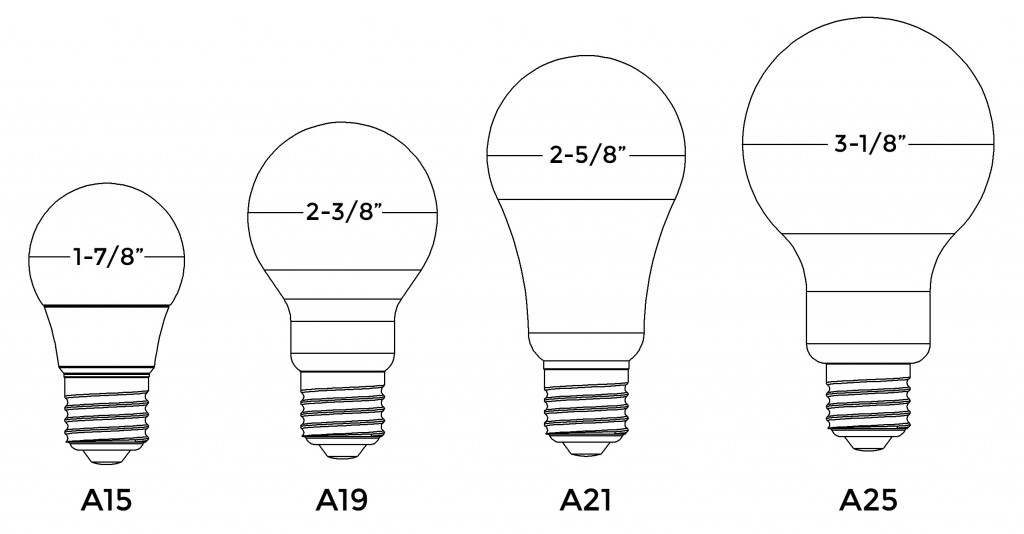
Most mutual base of operations types:
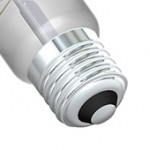
E26/E27 medium screw base
The G group: G11, G14, G16/G50, G60, G25/G80, G30 | Store At present

From tiptop left to bottom right: G14 LED bulbs in ceiling light fixture, G30 LED bulbs in bath vanity, G30 LED filament bulb in porch light fixture, G16 gold-tint LED filament bulbs in ceiling light fixture
World (G) bulbs take a full, round shape and are available in various sizes. They can exist used for many applications throughout the home, such every bit foyer lights, kitchen lights, chandeliers, and ornamental fixtures. The nearly mutual blazon is the large G30 bulb, which is used in bathroom and makeup vanities.
Depending on the bulb, numbers in each lawmaking can refer to the seedling's bore in one-eighths of an inch or in millimeters.
G11 bulb: 11/8 = i-3/8″ bore
G14 bulb: 14/8 = 1-3/4″ diameter
G16/G50: sixteen/8 = 2″ diameter
G60: 60 millimeters = 2-three/8″ bore
G25/G80: eighty millimeters = 3-9/64″ diameter
G30: 30/8 = iii-3/4″ bore
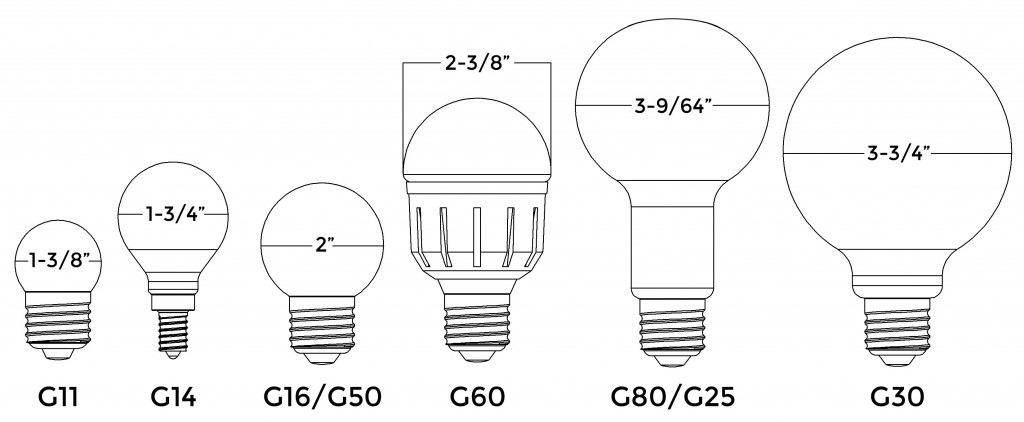
Most common base types:

E26/E27 medium screw base

E12 candelabra
The B and C groups: B10, C7, C9, C15, CA10 | Shop Now

From left to right: B10 LED bulbs in wall sconce, CA10 LED bulbs in chandelier, C9 LED bulbs in Christmas calorie-free strings, C7 LED bulb in night light
All of the bulbs in these groups resemble the shape of a candle flame and are often referred to every bit candle bulbs. Conical (C) bulbs are shaped similar a cone. Conical athwart (CA) bulbs are shaped like a cone but have a bent tip. Blunt-tip (B) bulbs are very similar to C-type bulbs but take more of a torpedo or bullet shape. These bulbs can be used in chandeliers, wall sconces, pendant lights, night lights, decorative light strands, holiday light strands, and other decorative abode lighting applications.
Numbers in each lawmaking refer to the bulb's bore in one-eighths of an inch.
B10 bulb: 10/8 = one-1/4″ diameter
CA10bulb: 10/eight = one-1/iv″ diameter
C7 bulb: 7/8 = 7/eight″ diameter
C9 bulb: 9/8 = 1-1/eight″ diameter
C15 bulb: 15/8 = one-vii/8″ diameter
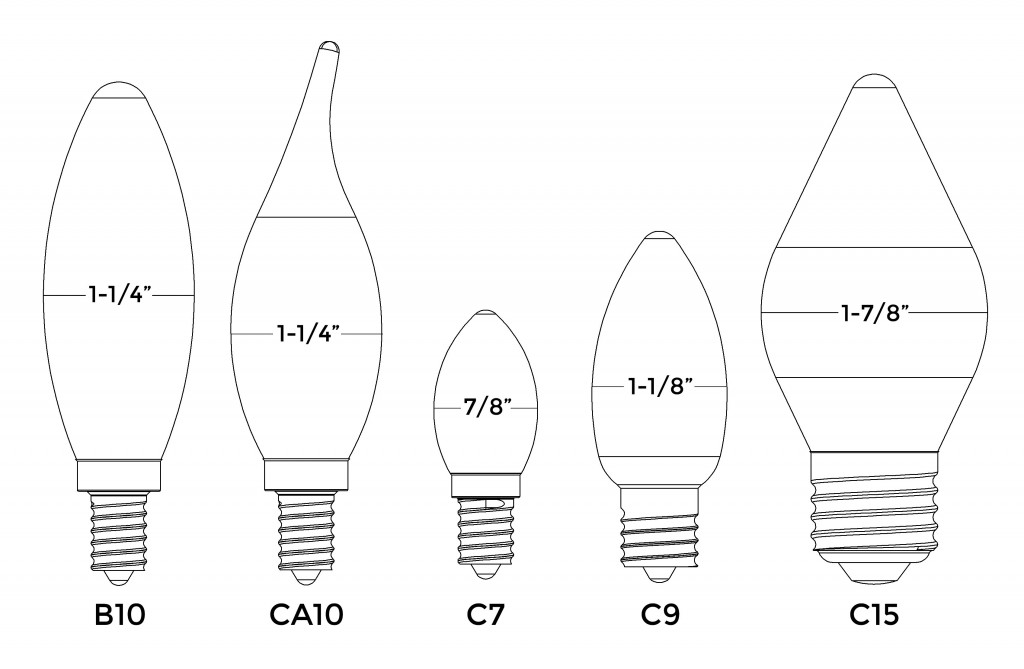
Most common base types:

E12 candelabra
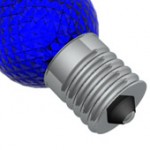
E17

E26/E27 medium screw base
The BR group: BR20/R20, BR30, BR40 | Shop Now

From top left to bottom correct: BR20/R20 LED bulbs in bedroom can lights, BR40 LED bulbs in living room can lights, BR30 LED bulbs in habitation theater tin lights, BR40 LED bulbs in kitchen can lights
BR stands for bulged reflector. Traditionally, the inside surface of an incandescent BR seedling is covered in reflector material that is used to assemble and cast a wide beam of lite away from the seedling. LED BR bulbs don't require the reflector cloth. These bulbs tin have a frosted, clear, or patterned dome-shaped lens that diffuses light and provides a gradual fade into nonilluminated areas. BR bulbs too produce less shadows when compared to PAR bulbs. They're a bit longer than PAR bulbs and tend to beetle from light housings but are used in like applications, such as rail lights, recessed lights, display lights, or tin lights.
BR20 bulbs are oftentimes referred to as R20 but have the aforementioned characteristics of other BR seedling types. The R stands for reflector.
Numbers in each code refer to the bulb'southward diameter in one-eighths of an inch.
BR20/R20 bulb: xx/viii = 2-one/two″ bore
BR30 seedling: 30/8 = 3-3/4″ diameter
BR40 bulb: 40/viii = 5″ diameter
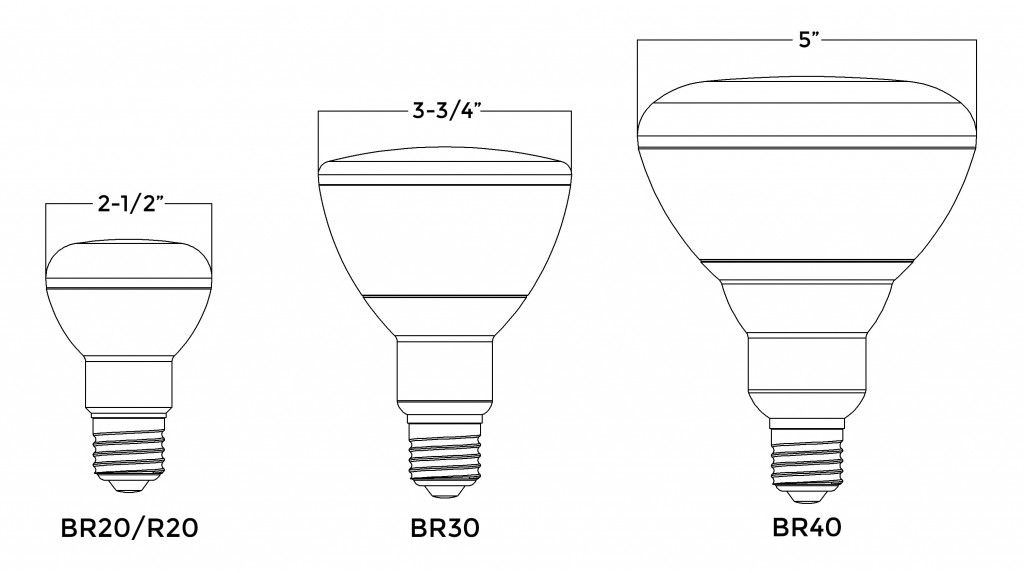
Most common base type:

E26/E27 medium screw base
The PAR grouping: PAR16, PAR20, PAR30, PAR36/AR111, PAR38 | Shop Now

From summit left to bottom right: PAR16 LED bulbs in ceiling fan fixture, PAR30 LED bulbs in recessed soffit light fixtures, PAR16 LED bulbs in eyeball low-cal fixtures, PAR38 LED bulb in kitchen can light
PAR stands for parabolic aluminized reflector. In traditional incandescent PAR bulbs, a U-shaped reflector is used to maximize effulgence and directly low-cal through the front of the bulb in a narrow spot beam or wide flood beam pattern. Oftentimes, LED PAR bulbs will not have a reflector simply will still deliver the hard-edged lighting (less of a gradual fade than BR bulbs) that is typical of incandescent PAR bulbs. These bulbs have a shorter torso than BR bulbs and usually install flush with ceilings or fixtures, which reduces glare. They're ordinarily plant in outdoor emergency calorie-free, spot light, or floodlight fixtures only tin can likewise exist used indoors for track lights, recessed lights, display lights, or can lights.
PAR36 bulbs are sometimes referred to as aluminized reflector (AR111) bulbs. They're shaped differently than other PAR bulbs in that they have a fairly low-profile body. The insides of these bulbs are coated in a reflector material or consist of faceted reflectors. LED bulbs don't require the reflectors just oft utilize them anyway. Similarly to other PAR bulbs, they emit focused, difficult-edged lighting in a spot or flood beam pattern. These bulbs run on low-voltage AC/DC wiring systems and are neat for outdoor and mural lighting applications such as architectural lights, driveway lights, path lights, gazebo lights, and paver lights that accept weatherproof housings.
Numbers in each code refer to the bulb's diameter in one-eighths of an inch. The numbers later "AR" refer to the seedling'due south bore in millimeters.
PAR16 bulb: 16/eight = ii″ bore
PAR20 bulb: 20/eight = 2-1/2″ bore
PAR30 bulb: 30/8 = 3-iii/4″ diameter
PAR36/AR111 bulb: 36/8 = four-1/two″ bore
PAR38 seedling: 38/8 = 4-3/4″ diameter
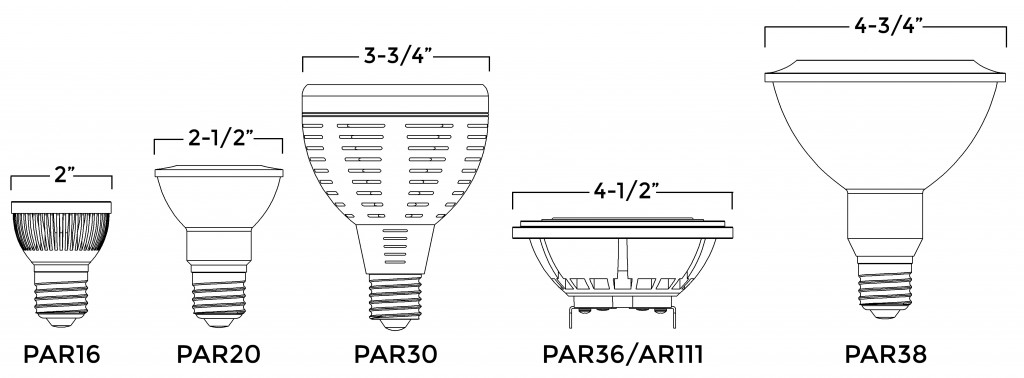
Nearly common base types:

E26/E27 medium screw base
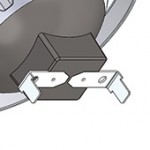
G53 screw pin
The MR group: MR11 and MR16 | Shop Now

From summit left to bottom right: MR11 LED bulbs in bollard lights, MR16 LED bulbs in ceiling fan fixture, MR11 LED bulbs in path lights, MR16 LED bulbs in kitchen rails light fixture
Multifaceted reflector (MR) bulbs are small in size with a reflective, faceted interior. The facets create a concentrated beam of light that can exist displayed in a narrow spot or wide inundation axle design. Because of the directional calorie-free they provide, MR LED bulbs don't crave the facets but oft notwithstanding have them. These bulbs are available in a variety of colors and can be used for many applications, including track lighting, recessed lighting, desk lights, and brandish case lighting. Many MR bulbs operate on low-voltage wiring systems, which makes them bang-up for outdoor and landscape applications such every bit driveway lights, path lights, gazebo lights, paver lights, and malibu lights that have weatherproof housings.
Numbers in each lawmaking refer to the bulb's diameter in one-eighths of an inch.
MR11 bulb: 11/eight = 1-3/8″ diameter
MR16 bulb: sixteen/eight = ii″ diameter
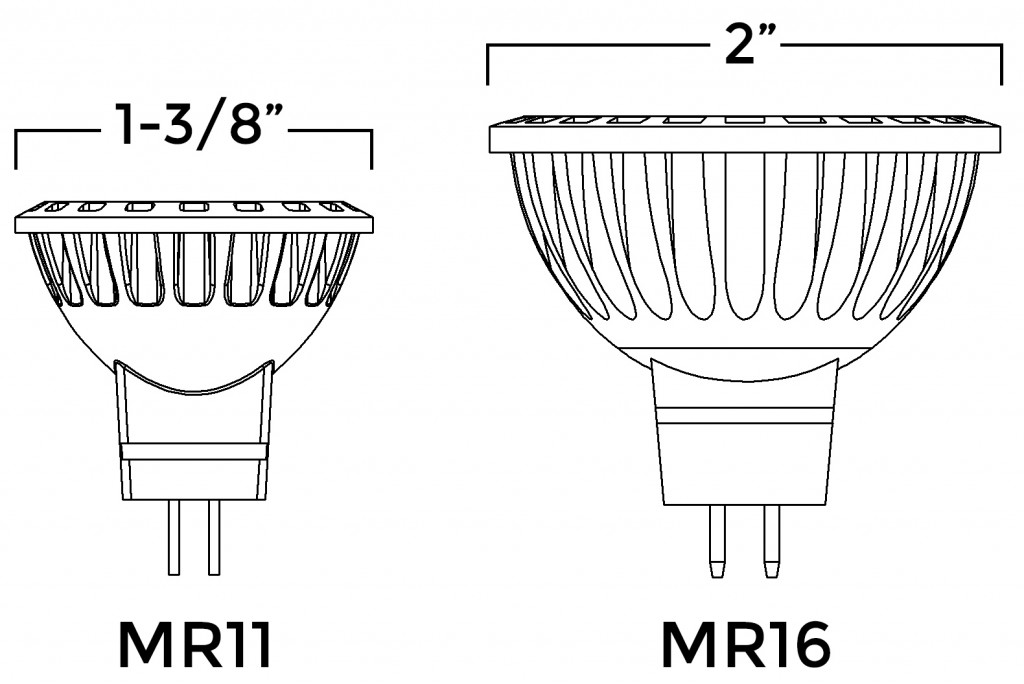
Nearly common base of operations types:
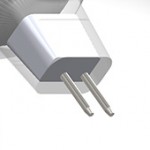
GX5.three bi-pin – in low-voltage Air-conditioning/DC systems
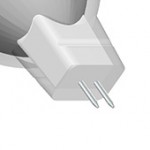
GZ4 bi-pin – in low-voltage Air-conditioning/DC systems
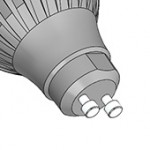
GU10 bi-pin – in 120-volt systems
The T group: T7, T8, T10, T14 | Shop At present

From height left to bottom right: T7 LED bulb in wall sconce, T14 LED bulbs in bathroom vanity light fixture, T8 LED bulbs in garage tube lite fixture, T10 LED bulb in freezer
Tubular (T) bulbs come in a variety of lengths and widths. Depending on their size, these bulbs can exist used in applications ranging from chandeliers, wall sconces, and pendant lights to basement and garage troffer light fixtures.
Numbers in each lawmaking refer to the seedling's diameter in i-eighths of an inch.
T7 seedling: 7/8 = 7/8″ diameter
T8 bulb: 8/8 = ane″ diameter
T10 bulb: ten/8 = i-1/four″ bore
T14 bulb: 14/8 = ane-3/4″ diameter 
About common base of operations types:

E26/E27 medium screw base

E12 candelabrum

E17
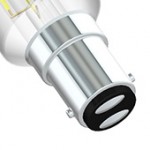
BA15D bayonet
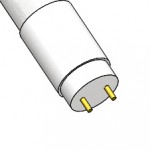
G13 bi-pin
Shop by Bulb Shape or Base of operations with our Universal Bulb Finder

What Size Flood Light For A 3 Inch Can,
Source: https://www.superbrightleds.com/blog/home-lighting-101-guide-understanding-light-bulb-shapes-sizes-codes/2315/
Posted by: cummingsparses.blogspot.com


0 Response to "What Size Flood Light For A 3 Inch Can"
Post a Comment